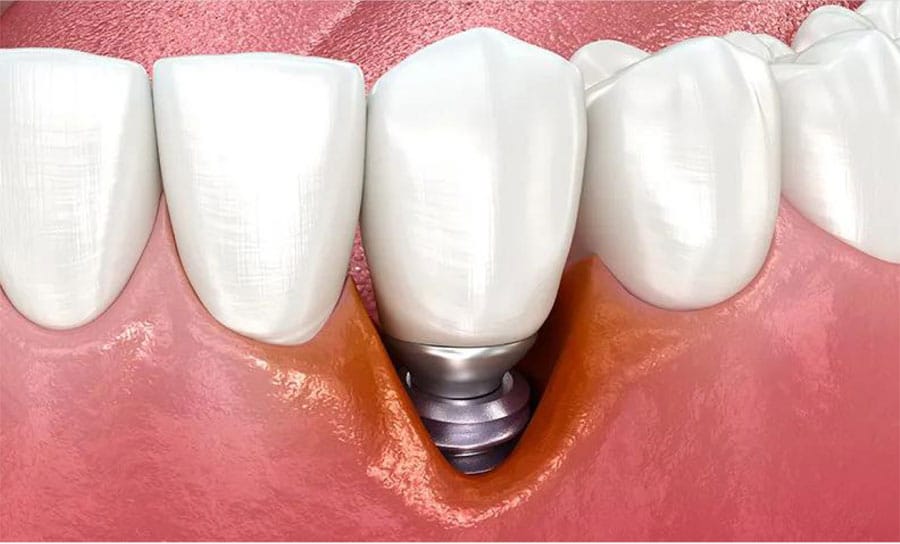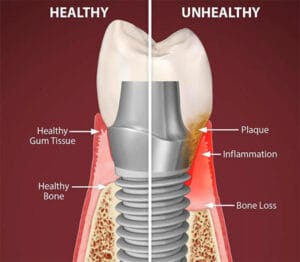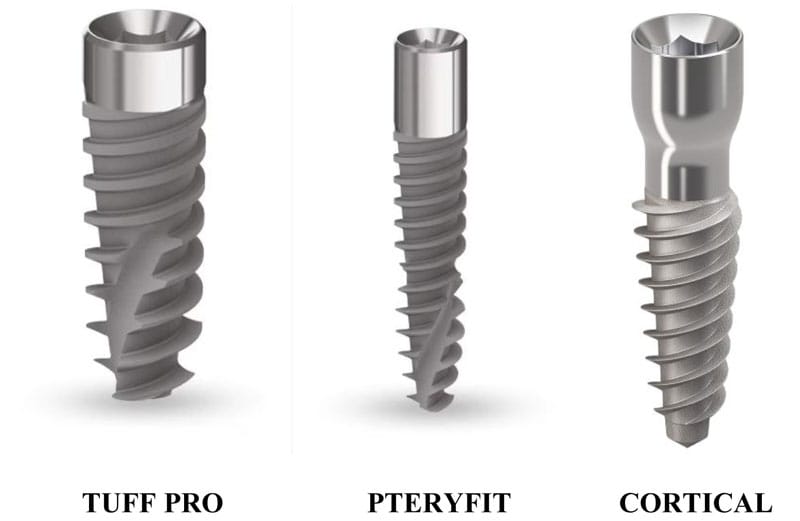
Dr. K Sharada Reddy, Author
Senior Dentist & Full Mouth Rehabilitation Expert
Unlock the Key to Long-Term Implant Success
Dental implants are an innovative revolutionary solution for replacing missing teeth, offering long-term stability and natural functionality. However, despite their high success rate, one significant complication that can threaten the longevity of dental implants is peri-implantitis. This condition is considered the leading cause of implant failure. In this comprehensive guide, we will discuss peri-implantitis in detail, including its causes, symptoms, risk factors, prevention methods, and treatment options. Additionally, we will introduce the CPBCCI Protocol™, a revolutionary approach to prevent peri-implantitis using specially designed implants.
Peri-implantitis is an inflammatory progressive bacterial infection that affects the soft tissues that is the gums and bone surrounding a dental implant. It is similar to periodontitis but occurs around implants instead of natural teeth. If left untreated, it can lead to implant failure. Understanding its causes, symptoms, prevention, and treatment options is crucial for patients.

Peri-implantitis is a chronic inflammatory condition affecting the tissues surrounding dental implants. It typically starts as mucositis, a reversible inflammation of the soft tissues. If left untreated, peri-implantitis progresses to bone loss around the implant, eventually compromising its stability and leading to implant failure.
Causes of Peri-Implantitis
 Understanding the causes of peri-implantitis is crucial to prevent and manage the condition. The primary factors include:
Understanding the causes of peri-implantitis is crucial to prevent and manage the condition. The primary factors include:
- Poor Oral Hygiene Leading to Bacterial Infection, Inadequate oral care is a significant contributor to peri-implantitis. Neglecting regular brushing and flossing allows plaque buildup around the implant, leading to infection and an inflammatory response. Harmful bacteria penetrate the gum tissue, causing tissue damage and bone loss.
- Improper Implant Placement – Improper drilling or placement of implant, insufficient torque or stability while placing the implant can create spaces around implant, where bacteria can thrive. Improper implant placement or surgical errors may increase the risk of periimplantitis by creating conditions that favor bacterial colonization.
- Excessive Occlusal Forces, Overloading the implant with excessive biting or chewing forces can lead to microfractures in the bone, making the area more susceptible to infection. Placing required number of implants is a prerequisite for long term stability of the implants.
- Smoking- Tobacco use reduces blood flow to the gums and impairs healing, increasing the likelihood of peri-implantitis.
- Pre-Existing Periodontal Disease, Patients with a history of gum disease are at higher risk of developing peri-implantitis due to the lingering presence of harmful bacteria.
- Systemic Conditions -Conditions such as diabetes and autoimmune diseases can impair the body’s immune response, making it harder to fight off infections.
- Bruxism (Night Grinding) Night grinding is also a predisposing factor for peri-implantitis.
Symptoms of Peri-Implantitis
Recognizing the early signs of peri-implantitis is essential for prompt intervention. Common symptoms include:
- Red, swollen, or tender gums around the implant site.
- Bleeding when brushing or flossing.
- Pus discharge from the implant area.
- Deepening pockets around the implant.
- Receding gums exposing the implant threads.
- Implant mobility in advanced stages.
- Bad breath or a foul taste in the mouth.
- Pain or discomfort when chewing.
CPBCCI Protocol™ : A Revolutionary Approach to Preventing Peri- Implantitis
The CPBCCI (Crestal Polished Bi-Cortical Conventional Implants) Protocol™, developed by Dr. K A Reddy, is a groundbreaking method in dental implants that addresses the risk factors associated with peri-implantitis. This protocol incorporates a special implant design that promotes healthier tissue integration and reduces bacterial colonization around the implant.

How Does the CPBCCI Protocol™ Work?
- Polished Crestal Collar, The CPBCCI Protocol™ uses implants with a polished crestal collar, a feature designed to minimize bacterial adhesion at the gum line. This polished surface creates a barrier that prevents harmful bacteria from penetrating the soft tissues and causing peri-implantitis.
- Bi-Cortical Engagement- These implants are designed to engage the cortical bone at the crestal and apical regions. This dual engagement provides superior stability and reduces the risk of implant micro movements that could lead to bone loss.
- Immediate Loading -The CPBCCI Protocol™ aids in immediate loading of teeth on implants in less than a week. This approach ensures that the implants are properly splinted and the functional forces that are subjected on them while chewing are evenly distributed aiding in bone formation and minimizing inflammation around the implant.
- Optimal Implant Placement-Precise implant placement techniques where the implants are tilted at an angle to ensure that the implant is positioned in proper bone, to avoid anatomical structures and vital nerves and also to place required number, diameter and length of the implants that is suitable for an individuals jaw, this promotes even distribution of the grinding forces and also to promote proper tissue healing. This further reduces the risk of periimplantitis
Role of CPBCCI Protocol™ in controlling peri implantitis in Diabetic Patients
The Crestal Polished Bi-Cortical Conventional Implants (CPBCCI Protocol™) offers a safe and effective solution for diabetic patients needing full-mouth rehabilitation. Unlike traditional implant methods that rely on prolonged healing, CPBCCI Protocol™ focuses on immediate loading and cortical bone engagement, which is particularly beneficial for diabetics. Immediate loading of implants prevents open wounds, reducing the risk of post-operative infections. Diabetics are prone to gum infections, which can lead to implant failure. The implants used under CPBCCI protocol™ are designed to resist peri-implant infections, ensuring long term success with simple oral hygiene maintenance. With its minimally invasive nature, bicortical stability and immediate loading, CPBCCI Protocol™ is an ideal choice for diabetics needing dental implants.
Prevention of Peri-Implantitis with the CPBCCI Protocol™
The CPBCCI Protocol™ is a game-changer in preventing peri-implantitis. Here are the key benefits:
- Reduced Bacterial Colonization.
- Enhanced Bone Stability.
- Improved Tissue Health.
- Faster Healing.
Treatment Options for Peri-Implantitis
Treatment for peri-implantitis depends on the severity of the condition. Early intervention is essential to prevent further bone loss and save the implant.
Non-Surgical Treatment
- Antimicrobial Therapy.
- Laser Therapy.
- Mechanical Debridement.
- Antibiotics.
Surgical Treatment
- Flap Surgery.
- Bone Regeneration.
- Implant Removal.
Conclusion
Peri-implantitis is a significant threat to the longevity of dental implants and is the leading cause of implant failure. With so many treatment options available to treat peri-implantitis in the initial stages, why not focus on prevention rather than cure? The CPBCCI Protocol™ offers a revolutionary approach that minimizes the risk of peri-implantitis from the start, ensuring long term implant success. Instead of searching for solutions to treat complications, choose an implant protocol (CPBCCI Protocol™) designed to prevent them in the first place!
Looking for Affordable teeth implants in India? Wondering about the Full mouth dental implants cost in India? Get insights on the cost of one dental implant in India and Zimmer dental implants in India today!




